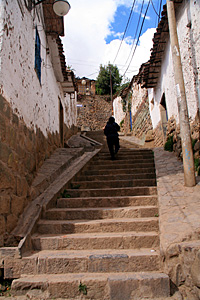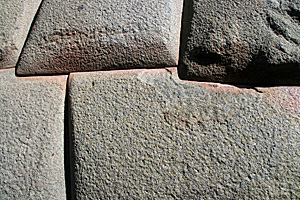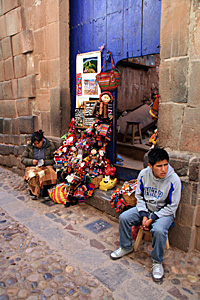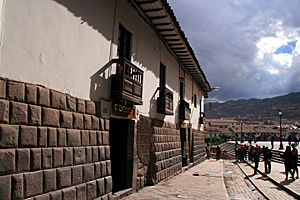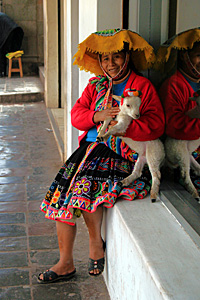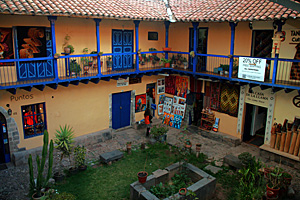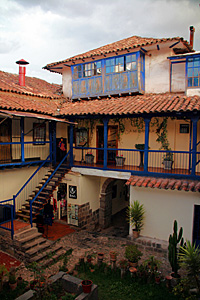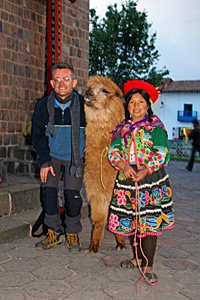|
||||||||||||||||||||||||||||
|
||||||||||||||||||||||||||||
Home > Treks > Outside Australasia > Inca Trail > 1 |
||||||||||||||||||||||||||||
|
||||||||||||||||||||||||||||
Introduction to today's journeyThere's a particular style that is very Peru that you don't see anywhere else; it's got so many different imprints. When you mix Incan minimalism with the heavy, ornate Spanish Baroque, it is very interesting. - Mario Testino. Today's journey takes me out of the Amazon basin flying over the Andes to the Incan capital city of Cusco. Here I explore the city acclimatising to the high altitude. Today's JourneyDistance trekked today: 2 kilometres. Total distance trekked to date: 2 kilometres. THE FIRST thing I noticed in Cusco was the air - or the lack of it. Having flown from the humid Amazon at 180 metres above sea level to land in the dry alpine air at 3450 metres above sea level, the difference was phenomenal. The air pressure here was less than two thirds of that in the Amazon, requiring me to breathe twice as hard to get the same amount of oxygen. When the plane doors opened I had felt the rush of pressurised air leaving the cabin. Walking through the terminal I had felt rather dizzy with a mild headache.
Upon leaving the terminal I noticed the sharp drop in temperature. It drops by six degrees for every thousand metres of altitude gain. It had been hot and humid in the Amazon. Here it couldn't have been any more than ten degrees even though it was the middle of the day. The cold biting breeze created additional wind chill. Cuzco is a small city sitting in a bowl shaped valley surrounded by rounded mountains covered in brown grass. These mountains towered over a kilometre high above us. This didn’t seem very significant from up here, but with our altitude their summits were four and a half thousand to nearly five thousand metres above sea level. The city itself didn’t seem to be anything dramatic until reaching the old quarter. The van I was travelling in turned off and followed a very narrow paved street steeply rising out of the valley. I really didn’t want to go any higher here, but that was where we were obviously going. Once at the end of the street, we turned into what would turn out to be quite a maze to head further up the hill. The very narrow streets were very short and erratic, no doubt built in a time long forgotten centuries before cars had been invented. On either side of the narrow streets stood stone buildings. Most were covered in white stucco, but many showed the stone wall constructions of the Inca. The tops of the buildings were clearly a Spanish style reminiscent of the downfall of the Incan empire during the Spanish inquisition.
Finally we stopped at an intersection. By now we were a good three thousand five hundred and fifty metres above sea level, a hundred metres above the airport. The van couldn’t turn around into the street where the hotel was because the turn was too tight, so we got out and took our bags. Gasping for breath, we walked the remaining fifty metres to the hotel. Although fifty metres doesn’t sound like much, it was quite a challenging hike when you are suddenly in an environment starved of oxygen. The lighting in the Amazon forest had been very soft, diffused by the blanket of haze from the evapotranspiration of the vast forest. Here the contrasts in light and shade, heat and cold were stark. The air was very dry and the radiation therefore very strong even though it was very cold here. With the glass windows sheltering us from most of the wind, it was actually quite pleasant sitting in the sun, but it was freezing in the shade. The contrast between light and shade was amazing. I rested at the hotel for about half an hour before meeting back with my tour group. Expecting the temperature to continue dropping over the afternoon, I put on my blue polar fleece top, and the thermal ski trousers I had bought in Lima. I also put on my hiking boots, looking like I was ready for some extreme polar hiking.
Most of the group assembled at the hotel entrance. The only exception were Michael and Julia, a couple from Perth. Michael had caught a severe stomach bug in the Amazon overnight and was resting in his room this afternoon with Julia. They had arranged for a doctor to see him even though he was starting to feel better. The sudden change in altitude and climate wouldn’t be doing him any good. The rest of us left the hotel and walked down the narrow streets towards the city. The streets were paved with cobblestones. There were narrow footpaths beside the street so we could get out of the way of cars even though we would have to almost lean against the whitewashed rendered walls of the houses. Fortunately there wasn’t much traffic as the streets were single laned, and very narrow at that. The streets were quite steep, so the footpath was often stepped.
A solid wall lined each side of the street. Within these walls were small doors and windows indicating the houses and shops which were joined together. The walls were always white, and the doors were almost always blue. There was some significance to this. I think it was just a local law. The windows were always small. A stone staircase running between a couple of the streets provided a shortcut towards wherever we were going. Luis definitely seemed to know where we were going, and thankfully we were all walking along at a very slow speed. My tour leader Luis lives here in Cuzco, so he felt right at home here having lived all of his life here in the thin air. No doubt he will be going home after today’s tour and tonight’s briefing. --- Cuzco was initially established as the Incan capital strategically marking the central point between the empire’s four huge provinces, one to the north-east, one to the north-west, one to the south-west, and the other to the south-east. All four provinces converged in Cuzco.
At its peak the kingdom extended down much of the length of the Andes between Colombia and Santiago. They preferred the lofty mountainous areas, avoiding the coast and the Amazon. The reign of the Inca had been rather short, lasting only a hundred years or so. Despite that they had built the most incredible infrastructure, including sixteen thousand kilometres of stone trail across the entire region. That was sobering to think. The forty six kilometres I had trekked over the Inca Trail only represented one part in three hundred and fifty of the entire network, and they had built all of it without the wheel. The empire had grown very well under very strong leadership until it was suddenly overthrown by the Spanish Inquisition.
The Spanish had brought Roman Catholicism to the region, replacing the long established Incan animism. Although the indigenous people adapted well to the Catholic traditions, they brought in their traditional customs into their religious practice to provide a unique expression of the Catholic religion. For instance traditionally when an Incan emperor died, their bodies would get mummified by leaving them outside in the sun by day, and frost by night. After numerous weeks they would essentially freeze dry into a state of permanent preservation. Every year the kings past would be paraded around the square in Cuzco. The ritual stopped once the Spanish had taken over and replaced their animistic Incan values with Catholic doctrine. However even today they parade life sized statues of the Catholic saints around the square on All Saints Day in exactly the same manner as they had paraded their dead kings. As an interesting side note, the Inca had developed the drying mummification process very well, and towards the end of their reign, they applied the same process with llama meat, drying it out in the sun and frost until it was permanently preserved. They discovered that one it was preserved they could store the meat indefinitely and eat it at any time. They named the dried meat jerky. Incidentally jerky is the only Quechuan word used in the English language. Once the tour was finished, I returned to the city square to do a bit more exploring. By now the sky had become overcast and the air cold and damp. The gardens were immaculate with many plants brightly in flower under the trimmed weeping willows. ---
Amy and I decided to stay in town exploring some of the really interesting shops in the tiny entrances around the old quarter. One thing Amy and I had in common was we both had almost the same model camera. By now I had established everyone else in the group had a little credit card sized camera. Sadly most people with small cameras find the larger SLR cameras rather intimidating especially when I hand it over to them to take a picture of me. At least Amy was familiar with large cameras, so we tended to stick together and when needed, swap cameras to take each other’s picture.
Everyone else in the group were keen to return to the hotel being so exhausted from the high altitude. Amy and I were getting used to it now. We would reach a small archway, and upon looking inside we would find a courtyard with numerous shops on two levels. There was a whole world inside these tiny entrances that we would have otherwise just walked right past. The shops had orange cream coloured walls and bright blue framing on the verandas. The courtyard had numerous cactus plants local to the area growing in amongst the mowed grass and shrubs. I bought some souvenirs, including an alpaca scarf and mittens which I would wear when in very cold parts of the world – including here. Amy bought a very nice red and black alpaca jumper which she wore for most of the remainder of the trip. We continued exploring the city, gradually working our way back towards the hotel. The cloud had by now cleared but the sun was getting very low in the sky. There was quite a nip in the air now. We would enter little alleys containing tiny shops in amongst the ancient Inca walls interspersed with the white washed stucco walls of the modern buildings. Some of the modern walls had large cracks running down them from fairly recent earthquakes. The stone walls were built to have resisted even the most severe earthquakes of the past five hundred years since they were built.
We found a lady with an alpaca and got photos there. Then it was starting to get dark with the sun down and cloud covering us again. It was time to head back. We both had cards of the hotel we were staying in, and we quickly found the road listed on the card. We walked along the narrow road which fortunately followed the same contour, but we reached the end of it without finding the hotel. Fortunately Amy had her phone and decided to call Luis who got a taxi and somehow found us just a couple of minutes later. The taxi took us through quite a detour, but this was apparently one of those roads that was cut off in the middle. The dead end we had reached was a few buildings that had been built in the middle of the road. We had been within a hundred metres of the hotel though, and could have easily walked there by taking a loop up the hill to return to the road. The streets here were so confusing that even I had become lost. That was a first for me. Luis, Amy and I returned to the hotel just in time for the briefing. The rest of the group were already sitting on couches in the briefing room under the glass walkway between the reception and my room. A fire was lit and roaring in the fireplace creating a very welcome warmth. In front of the group were two very fit looking deeply tanned men who had just arrived and were now ready to start briefing us. They handed out a map to each of us and introduced themselves.
The chief guide was Wilbur. He had a chiselled face and was wearing a New Zealand black silver fern shirt under his orange polar fleece top. Intriguing. He performed the entire briefing. His offsider was his assistant guide Carlos who didn’t say much during the briefing. As far as I could tell, they both looked like genuine Incan descendants. Wilbur took us through what to expect each day. The first day will be mostly a well graded track passing through arid farmland owned by Incan descendants. The trail will start by following the Urumaba River downstream before we turn off up a tributary. On the second day we will be going through more remote mountainous territory where we will be climbing over the first two of three passes on the trail. The first pass is the highest, which we will be crossing on the morning of the second day. This will be followed by a steep descent to a campsite where we will have lunch before crossing the second pass to our campsite for the night. The first two days will have about eight hours walking each.
The third and fourth day will be about four hours each. The third day will be through forest going over the third and final pass, although there is almost no climb to reach the top. Over the pass it will all be downhill over a thousand metres down to the next campsite. The fourth day will take us through the Sungate, then onto Machu Picchu. Wilbur handed out duffel bags for us to fill with our sleeping bags (which he also handed out for those of us who hired them), clothes, and whatever else we wanted to put in them. We could put anything in our bag so long as it didn’t weigh any more than six kilogrammes. The porters will need to carry them, and unlike Mount Kinabalu, the porters had a weight limit with not being allowed to carry any more than twenty five kilogrammes each. If any porters are carrying any more than the allowed twenty five kilogrammes, the tour company will be fined.
Most of the others in the group hired hiking poles. I had brought my own pole with me, though I still didn’t have a rubber tip which was compulsory here. I had tried getting one back at home, and again in the camping store I had visited in the shopping centre at the edge of the cliff in Lima, but neither store had them even though they knew exactly what I was talking about. I hired a sleeping bag. I could have brought one back home to use for travelling, but I find these are very bulky especially as I was only using it for a few days. Weight and space are critical in packing for travel, so anything I can leave at home and hire when needed gets left at home. Wilbur and Carlos handed out our hired gear outside in the courtyard a few minutes following the briefing. It was completely dark now and across the garden we had an amazing view of the constellations of street lights over the hills on the other side of the city. Once we were all equipped and had taken our stuff back to our rooms, we went out for dinner to a restaurant where we ate guinea pig and alpaca meat. |
||||||||||||||||||||||||||||
|
||||||||||||||||||||||||||||

